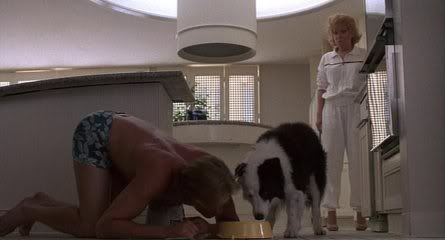
"And you may know how little God thinks of money by observing on what bad and contemptible characters he often bestows it." -- THOMAS GUTHRIE (1865)
Disney's making dirty movies!
Well, no. Not really. But that was the consensus among prudes, alarmists, and moral watchdogs alike in the mid-1980s when the Walt Disney Company began financing a series of R-rated movies through a then-fairly-new subsidiary of theirs called Touchstone Pictures. Never mind that the hallowed "D" word never appeared anywhere in these films' credits or advertising. The evidence was clear: a bastion of good, clean, wholesome family entertainment was now up to its mouse ears in the smut racket. Won't someone please think of the children?
I can still remember then-also-newish Disney CEO Michael Eisner appearing on ABC's 20/20 and squirming genially as a reporter showed him a particularly risque clip from of one of Touchstone's latest offerings, Down and Out in Beverly Hills and asked him if this sort of thing was appropriate for Disney to be releasing. The clip involved Richard Dreyfuss as a wealthy married man having adulterous sex with his maid while the family dog watches through a window. To make matters worse, the maid was actually on top during said fornication, a clear breach of missionary-position-only sexual protocol. (NOTE: This was long before Disney actually owned ABC. Wonder if the same kind of story would air on 20/20 today?) Eisner's answer, as you might guess, was political. Down and Out, he faux-cheerfully explained, was not really a Disney movie per se, at least not in the Bambi/Snow White sense. It was just an adult-oriented comedy which happened to be financed by the Walt Disney Company. That's all.
Disney, you must remember, had spent much of the 1960s and all of the 1970s flooding the film market with gimmick-laden, low-ambition "family comedies" aimed at the notoriously undiscriminating kiddie audience. Think: lots and lots of Herbie sequels and cute-animal flicks. As a result, the term "live-action Disney movie" was not exactly synonymous with "quality," and even that particular teat had run dry by the end of the Carter years. Disney continued to make live-action films in the 1980s, but these tended to be adventure and fantasy stories, like Tron and The Journey of Natty Gann. The only way for Disney to make live-action comedies and dramas that adults might actually pay money to see was to do so under another name. Ergo, Touchstone. And the gambit paid off beautifully with a string of well-received, financially-successful pictures. Today, the familiar circle-and-lightning-bolt insignia of Touchstone is just another meaningless corporate logo, imparting nothing of significance to the average moviegoer. But for a few years there in the mid-to-late 1980s, Touchstone Pictures was something of a brand name to critics and knowledgeable audiences alike, much as, say, Judd Apatow's name is today. A Touchstone comedy was generally expected to be a little sharper, a little fresher, a little funnier than the average multiplex offering. The company even had its own stable of stars, veteran film and TV performers who appealed more to parents than to kids: Richard Dreyfuss, Danny DeVito, and of course the Queen of Touchstone herself, Miss Bette Midler, who vaulted back into stardom with her appearances in Down and Out in Beverly Hills and Ruthless People, both released in 1986.
